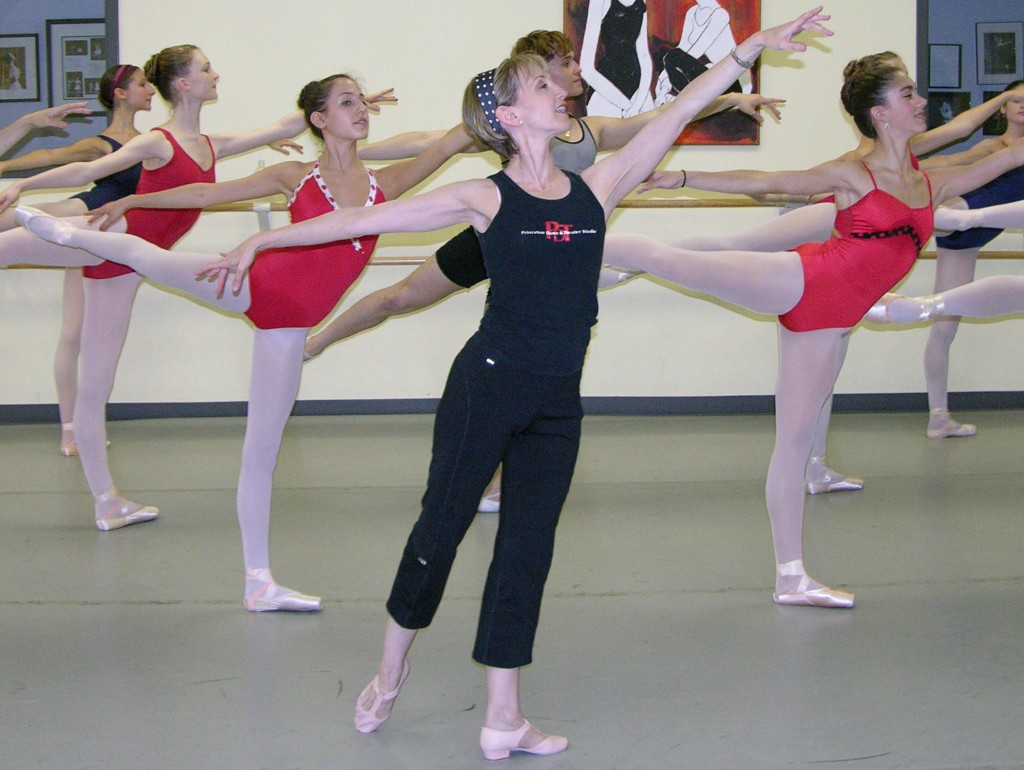by Risa Gary Kaplowitz
I have just been reviewing my latest masterpiece. It’s not what you think. It’s the schedule for my dance studio’s upcoming summer intensive. The process of completing this seemingly never-ending logistical nightmare is akin to choreographing a do-se-do of guest instructors, permanent staff and three student levels. Just one other job is harder–finding the right teachers to fill the slots.
The criteria of hiring guests and regular staff are very different from each other. For the prominent roster of guests, I am mostly interested in what they have to offer our students for the relatively limited amount of time (anywhere from 2-6 days) that they are with us. The students and I are so fortunate to have a solid core of exceptional guest teachers year after year. This summer, ballet legends Susan Jaffe, Cynthia Gregory, and Kyra Nichols, and former principal and current Pennsylvania Ballet Artistic Director, Roy Kaiser will share priceless wisdom with us as they have done for several years.
But hiring teachers who will teach for multiple weeks or multiple years takes more time to get right. I am lucky that my proximity to Manhattan makes finding a plethora of former professional dancers relatively easy. However, finding someone with important characteristics of a great teacher can be much more difficult. These are the ABC’s that I look for when auditioning a permanent dance instructor:
Adaptability – Moving on from the mindset of a dancer to that of teacher. I have come across former professional dancers who have really good intentions of sharing their knowledge with others but who have not yet adapted to their life off the stage. They are not yet emotionally ready to shed the need for the attention and drama that was intrinsic to their life as a performer. Dancers are so used to getting feedback and strokes from their teachers, coaches, and the audience that it may be difficult for them to step into the role of one who gives all of their attention to others. The transition from dancer to teacher may be also hampered by depression due to the loss of adrenaline rushes while performing.
How to get there: Early on in your dance career, be sure to gain life experience outside of dance. Attending college, volunteering, or having a strong family life will help stave off the starvation an applause-seeking ego may feel when the attention goes away. An effective teacher looks and acts the part of an adult who is not afraid of being a leader. This means wearing professionally modest apparel—students need to see your movements but not your body in the same way that a teacher or audience did when you were dancing. It also means displaying a professional but enthusiastic attitude. Even though you are not performing on a stage, you must still perform in class. Your face, body language, and personality set the tone for the entire class. If you find that you are depressed (as can happen when endorphins run low) or feeling neglected, the energy of the class will be lower than a grand plié. To help bring endorphins up, take up an aerobic exercise that can be done before teaching. Vinyasa yoga is a great option; it gets the heart rate up without beating down the body as, say, running can. Whatever you need to do in order to show your best self in every class, do it. Remember, performing continues in the classroom, only this time, your role is a supporting one.
Boundaries – Keep them clear: Understanding where to draw the line between being friendly and being a friend is one of the most important attributes that I look for in a teacher. As difficult as it is to find the gem of a dancer who was also born to teach, it is even harder to find one who maintains healthy boundaries outside of the classroom. A great teacher is someone who is nurturing in the studio but professionally distant outside of it.
How to get there: In the studio, learn every student’s name, whether you teach one class a week or twenty. Keep things relatively even in terms of corrections—my ideal is to give every student at least one or two individual comments per class. Outside of the studio, keep things even as well in terms of attention. This means not “friending” your under-age students. Despite the fact that it is widely acceptable to refer to dance teachers on a first-name basis (something that I personally don’t allow), I don’t think that it’s appropriate for an adult in an authoritative position to “friend” a minor in either the real or virtual world. Call me old-fashioned, but having a student read adult content on a teacher’s Facebook or twitter feeds, even if they speak about such things with their peers, is not cool. Maintaining boundaries is crucial to getting and keeping the respect you deserve.
Compassion, Confidence, and Clarity – Interdependent qualities: All three of these “C” traits are important in order to teach well. Compassion for your students should be evident always, but nice teachers are not necessarily the most effective. Along with the care, you must have confidence in order to push students out of their comfort zones. Yet, such confidence is not possible without the clarity of when to push or even how to teach basic skills. Often, dancers who want to transition into teaching cannot remember the process by which they learned the skills they executed with ease as a professional. A great teacher realizes that teaching has specific skill sets that cannot always be gained by simply having danced themselves.
How to get there: Being compassionate is the easy part; teachers are usually interested in helping others. Displaying confidence in the studio may be more difficult to come by. The best way to feel confident is to really know what you are talking about. I require all of my ballet instructors to have an American Ballet Theater® National Training Curriculum certification. It has provided all of us with a logical framework that keeps the training consistent throughout each level. Having a point of view that comes from a respected curriculum enables a teacher to be confident and clear on how and when to present skills.
Charisma – Be inspiring: This 4th “C” stands alone as it is so important. Professional dancers have used their bodies their entire career to express themselves, and it can be daunting to use their voice in a powerful way. Yet a strong voice helps to make sure a teacher connects to his or her students in a visceral way.
How to get there: Be personable (a little humor helps) and show great energy in class. Although your body may not be in the shape that it was as a dancer, you can make your voice express energy. Enticing students to go beyond their comfort zone is nearly impossible with a monotone voice that lacks power. If you do not have a naturally loud voice, work on making it as expressive as possible. If you do have a good volume, use it—not by yelling but by enthusiastically punctuating rhythm or certain skills like high jumps. You can have all of the knowledge and performing experience in the world, but if you can’t share it in a likeable and spirited way, your classes may not be as effective.
Bottom line: If you prepare to teach with the same intensity as you prepared to perform, you will have the privilege of sharing your pearls of experience, talent, and skills with the next generation. And what could be a better encore to your performance career?
Who is your favorite dance teacher and why?

Contributor Risa Gary Kaplowitz is a former principal dancer with Dayton Ballet and member of Houston Ballet and Manhattan Ballet. She has also performed with Pennsylvania Ballet and Metropolitan Opera Ballet and as a guest artist with many companies nationwide.
She was originally trained at Maryland Youth Ballet by Tensia Fonseca, Roy Gean, and Michelle Lees. She spent summers as a teen studying on scholarship at American Ballet Theater, Joffrey Ballet, Pennsylvania Ballet, and Houston Ballet. As a professional, her most influential teachers were Maggie Black, Marjorie Mussman, Stuart Sebastian, Lupe Serrano, Benjamin Harkarvy, and Ben Stevenson. She has performed the repertoire of many choreographers including Fredrick Ashton, George Balanchine, Ben Stevenson, Stuart Sebastian, Dermot Burke, Billy Wilson, and Marjorie Mussman.
After spending ten years in a successful business career while building a family, Risa returned to the dance world and founded Princeton Dance and Theater Studio (www.princetondance.com) and DanceVision, Inc. (www.dancevisionnj.org) with Susan Jaffe, former ABT principal ballerina. Risa is now PDT’s Director, and the Artistic Director of DanceVision Inc. Risa also founded D.A.N.C.E. (Dance As a Necessary Component of Education), an outreach program that brings dance to New Jersey schools.
Risa has choreographed more than twenty pieces, and her original full-length ballets, The Secret Garden and The Snow Queen, premiered with DanceVision Performance Company in 2008 and 2011, respectively. Additionally, she has choreographed for several New Jersey Symphony Orchestra family and school outreach concerts.
Risa is an ABT® Affiliate Teacher, who has successfully completed the ABT® Teacher Training Intensive in Primary through Level 7 and Partnering of the ABT® National Training Curriculum, and has successfully presented students for examinations.
She has lectured the ABT/NYU Master candidates on starting a dance studio. She is most grateful for her teachers who gave and (in the case of ABT® Curriculum) give her the exceptional tools necessary to have had a performance career and the opportunity to train others in authentically. She also feels fortunate to have had the opportunity to dance with and learn from many exceptional dancers.






good advice! 🙂
This is a great blog post! I am currently looking in to teaching, but am still performing. I would like to hear your thoughts on how to be a teacher and performer at the same time. Do you really have to choose one? I like that you mentioned settings boundaries not only in person, but on social media sites as well. I have seen this a lot lately where students are friends with teachers on Facebook. If that is the case, the teacher really needs to monitor what they post.
Risa, this essay contains so many great reminders about our roles as teachers (some of which I still aspire to achieve!). However, one thing I do take issue with is the need for a dance instructor to be a former professional ballerina. Not every great teacher (like an exceptional athletic coach) has been a pro. I have performed on stage in many capacities as a dancer but I never earned a living as a pro – performance did not drive me. But that doesn’t preclude me from being a good teacher.
Your summer program sounds like a tremendous opportunity for your students! Cheers and happy dancing~
Leigh
Lisa, I started teaching while I was still performing. It not only gave me valuable experience but it also helped me so much with my own technique…I don’t think there is a better way to learn than to have to articulate what you know and see your corrections on others. Good luck with it all!
Leigh, thanks for your response! I completely agree that you do not need to have been a professional in order to be a great teacher. The post was written from the angle that it was because I have found that former professionals are the ones that have the most trouble with the transition to teaching. In fact, the assistant director of PDT was a former student who went on to earn her MFA in dance and came back to teach for me. She is someone who never wanted to be a professional (although she certainly had the talent to do it) and she a great teacher.